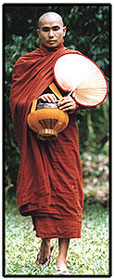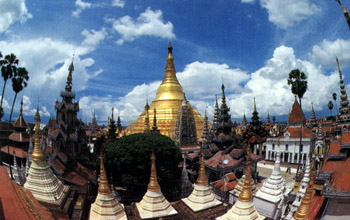 Buddhism in Burma (also known as Myanmar) is predominantly of the Theravada tradition, practised by 89% of the country's population It is the most religious Buddhist country in terms of the proportion of monks in the population and proportion of income spent on religion. Adherents are most likely found among the dominant ethnic Bamar (or Burmans), Shan, Rakhine (Arakanese), Mon, Karen, and Chinese who are well integrated into Burmese society. Monks, collectively known as the Sangha, are venerated members of Burmese society. Among many ethnic groups in Myanmar, including the Bamar and Shan, Theravada Buddhism is practiced in conjunction with nat worship, which involves the placation of spirits who can intercede in worldly affairs.
Buddhism in Burma (also known as Myanmar) is predominantly of the Theravada tradition, practised by 89% of the country's population It is the most religious Buddhist country in terms of the proportion of monks in the population and proportion of income spent on religion. Adherents are most likely found among the dominant ethnic Bamar (or Burmans), Shan, Rakhine (Arakanese), Mon, Karen, and Chinese who are well integrated into Burmese society. Monks, collectively known as the Sangha, are venerated members of Burmese society. Among many ethnic groups in Myanmar, including the Bamar and Shan, Theravada Buddhism is practiced in conjunction with nat worship, which involves the placation of spirits who can intercede in worldly affairs.With regard to "salvation" in the Buddhist sense, there are three primary paths in Burmese Buddhism: merit-making, vipassana (insight meditation), and the weizza path (an esoteric form of Buddhism that involves the occult). Merit-making is the most common path undertaken by Burmese Buddhists. This path involves the observance of the Five Precepts and accumulation of good merit through charity and good deeds (dana) in order to obtain a favorable rebirth. The vipassana path, which has gained ground since the early 1900s, is a form of insight meditation believed to lead to enlightenment. The third and least common route, the weizza path, is an esoteric system of occult practices (such as recitation of spells, samatha meditation, and alchemy) and believed to lead to life as a weizza (also spelt weikza), a semi-immortal and supernatural being who awaits the appearance of the future Buddha, Maitreya (Arimeitaya)
History
The history of Buddhism in Burma extends nearly a millennium. The Sasana Vamsa, written by Pinyasami in 1834, summarises much of the history of Buddhism in Burma. According to many historians, Sohn Uttar Sthavira (one of the royal monks) to Ashoka the Great came to Burma (Suvarnabhumi or Suvannabhumi) around 228 BC with other monks and sacred texts, including books.
The Ari Buddhism era included the worship of Bodhisattas and nagas, and also was known for corrupt monks. King Anawrahta of Bagan was converted by Shin Arahan, a monk from Thaton to Theravada Buddhism. In 1057 AD, Anawrahta sent an army to conquer the Mon city of Thaton in order to obtain theTipitakaBuddhist canon. Mon culture, from that point, came to be largely assimilated into the Bamar culture based in Bagan. Despite attempts at reform, certain features of Ari Buddhism and traditional nat worship continued, such as reverence of Avalokiteśvara (Lawka nat), a Boddhisatta. Successive kings of Bagan continued to build large numbers of monuments, temples, and pagodas in honour of Buddhism. Burmese rule at Bagan continued until the invasion of the Mongols in 1287.
The Shan, meanwhile, established themselves as rulers throughout the region now known as Burma. Thihathu, a Shan king, established rule in Bagan, by patronising and building many monasteries and pagodas. Bhikkus continued to be influential, particularly in Burmese literature and politics.
The Mon kingdoms, often ruled by Shan chieftains, fostered Theravada Buddhism in the 14th century. Wareru, who became king of Mottama (a Mon city kingdom), patronised Buddhism, and established a code of law (Dhammathat) compiled by Buddhist monks. King Dhammazedi, formerly a Mon monk, established rule in the late 15th century at Innwa and unified the Sangha in Mon territories. He also standardised ordination of monks set out in the Kalyani Inscriptions. Dhammazedi moved the capital back to Hanthawaddy (Bago). His mother-in-law QueenShin Sawbu of Pegu was also a great patron of Buddhism. She is credited for expanding and gilding the Shwedagon Pagoda giving her own weight in gold.
The Bamar, who had fled to Taungoo before the invading Shan, established a kingdom there under the reigns of Tabinshwehti and Bayinnaungwho conquered and unified most of modern Burma. These monarchs also embraced Mon culture and patronised Theravada Buddhism.
In the reigns of succeeding kings, the Taungoo kingdom became increasingly volatile and was overthrown by the Mon. In the mid- 18th century, King Alaungpaya defeated the Mon, expanded the Bamar kingdoms, and established the Konbaung dynasty. Under the rule of King Bodawpaya, a son of Alaungpaya, a unified sect of monks (Thudhamma) was created within the kingdom. Bodawpaya restored ties with Sri Lanka started by Anawrahta, allowing for mutual influence in religious affairs. In the reigns of the Konbaung kings that followed, both secular and religious literary works were created. King Mindon Minmoved his capital to Mandalay. After Lower Burma had been conquered by the British, Christianity began to gain acceptance. Many monks from Lower Burma had resettled in Mandalay, but by decree of Mindon Min, they returned to serve the Buddhist laypeople. However, schisms arose among the Sangha, which were resolved during the Fifth Buddhist Synod, held in Mandalay in 1871. From 1860 to 1868, the Tipitaka was engraved on 729 marble slabs and assembled in the Kuthodaw Pagoda. In 1871, a new hti (the gold umbrella that crowns a stupa) encrusted with jewels from the crown was also donated by Mindon Min for the Shwedagon now in British Burma.
During the British administration of Lower and Upper Burma, also known as Burma Proper, government policies were secular which meant monks were not protected by law. Nor was Buddhism patronised by the colonial government. This resulted in tensions between the colonised Buddhists and their European rulers. There was much opposition (including by the Irish monk U Dhammaloka) to the efforts by Christian missionaries to convert the Burmese people, Bamar, Shan, Mon, Rakhine and plains Karen, with one exception - the hill tribes. Today, Christianity is most commonly practised by the Chin, Kachin, and the Kayin. Notwithstanding traditional avoidance of political activity, monks often participated in politics and in the struggle for independence.
Since 1948 when the country gained its independence from Great Britain, both civil and military governments have supported Theravada Buddhism. The 1947 Constitution states, "The State recognizes the special position of Buddhism as the faith professed by the great majority of the citizens of the Union." The Ministry of Religious Affairs, created in 1948, was responsible for administering Buddhist affairs in Burma. In 1954, the prime minister, U Nu, convened the Sixth Buddhist Synod at Kaba Aye Pagoda in Rangoon (Yangon), which was attended by 2,500 monks, and established the World Buddhist University.
During the military rule of Ne Win (1962–1988), he attempted to reform Burma under the Burmese Way to Socialism which contained elements of Buddhism. In the 8888 Uprising, many monks participated and were killed by Tatmadaw soldiers. The current military regime, the State Peace and Development Council (SPDC) patronises Buddhism, although persecution of Buddhists contrary to the regime, as well as persons of other religions, namely Islam and Christianity, continues.





No comments:
Post a Comment